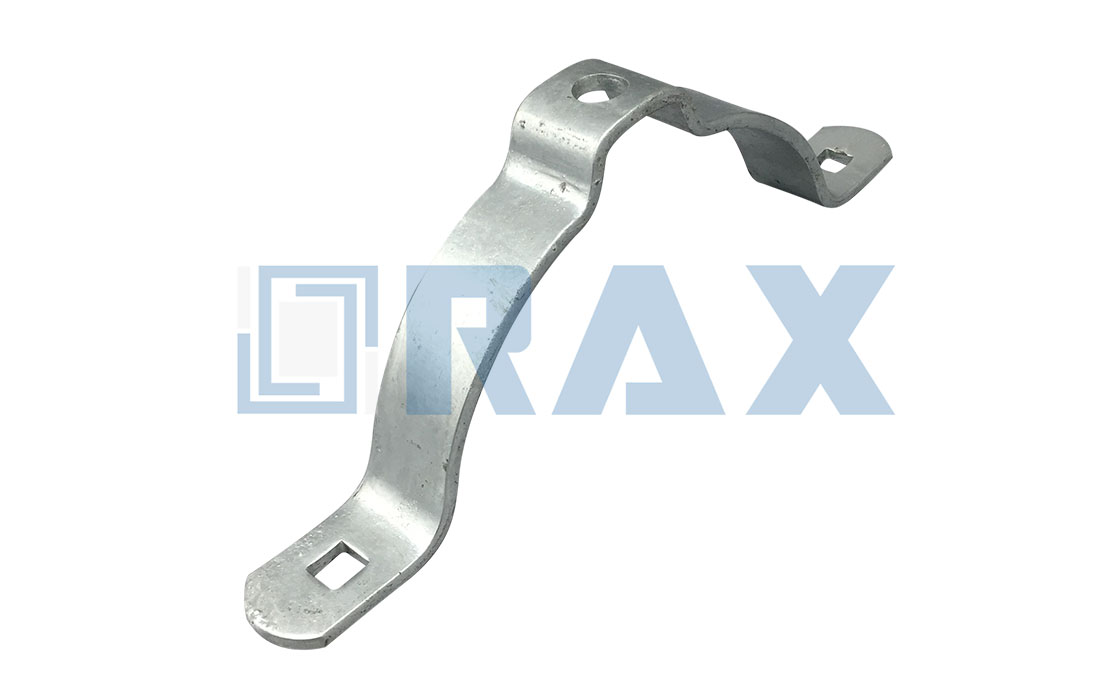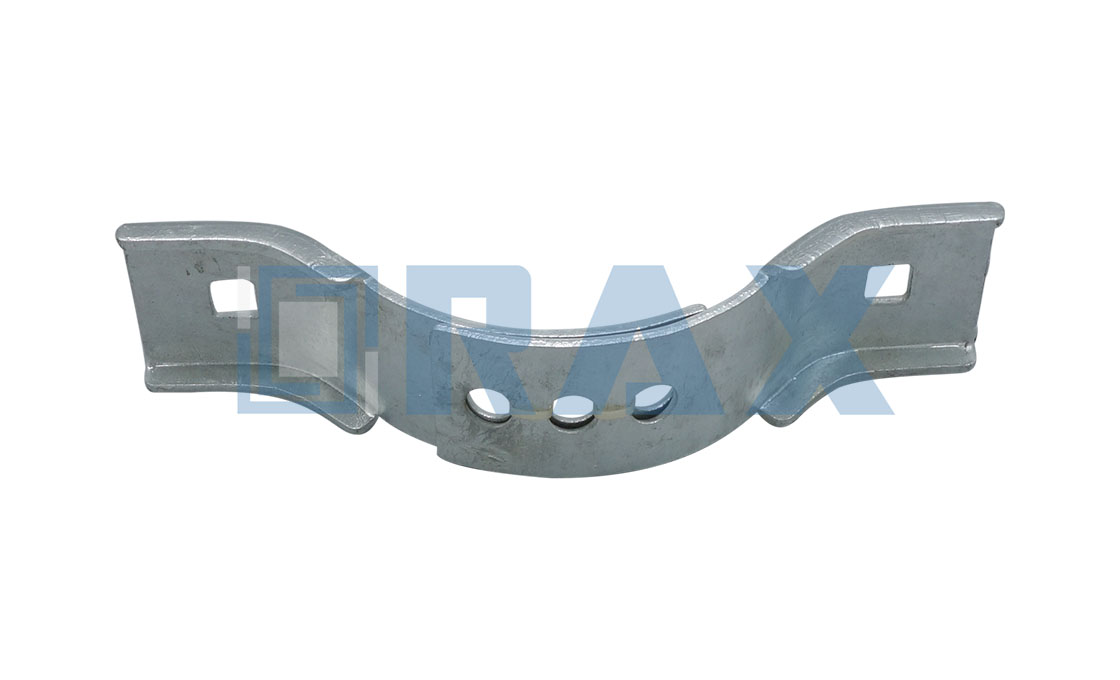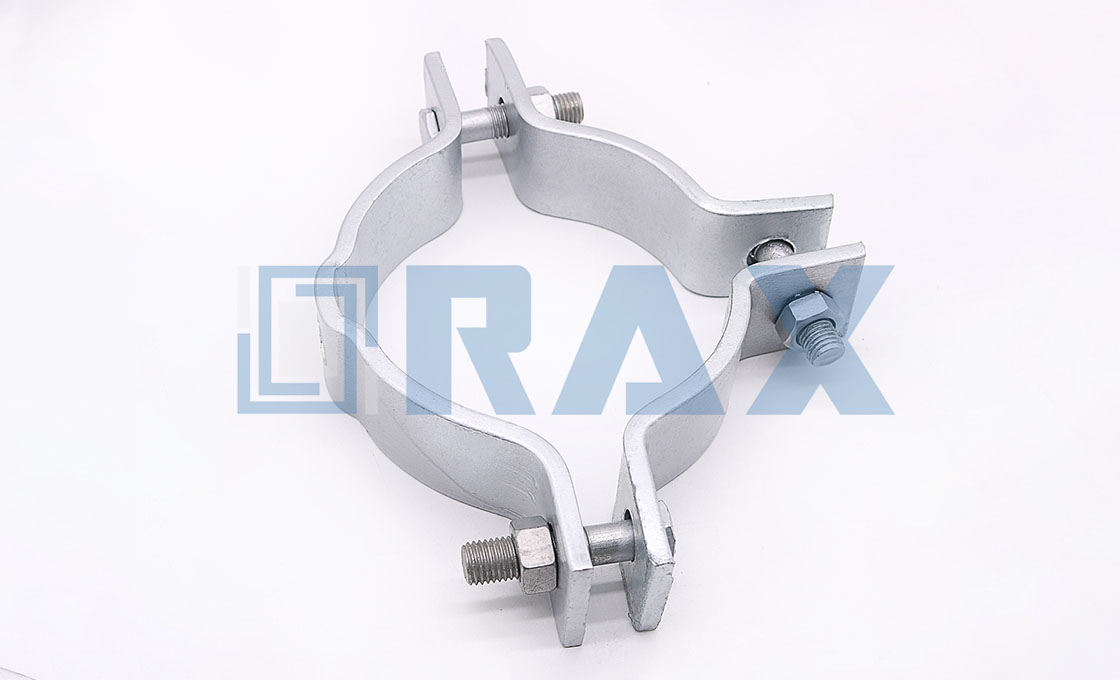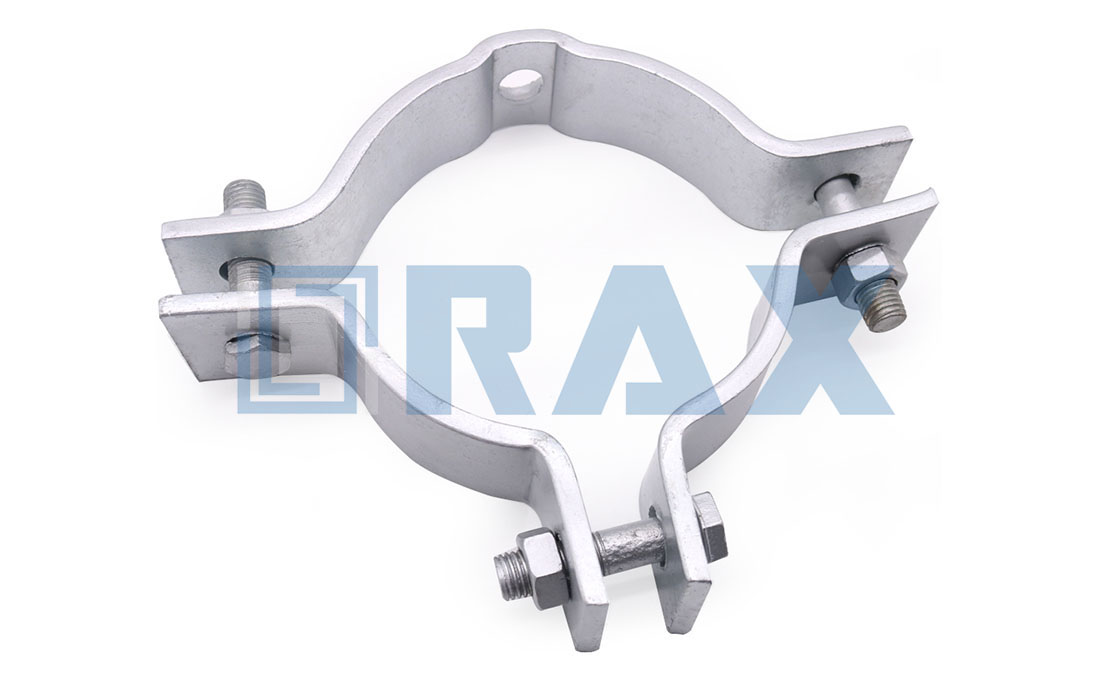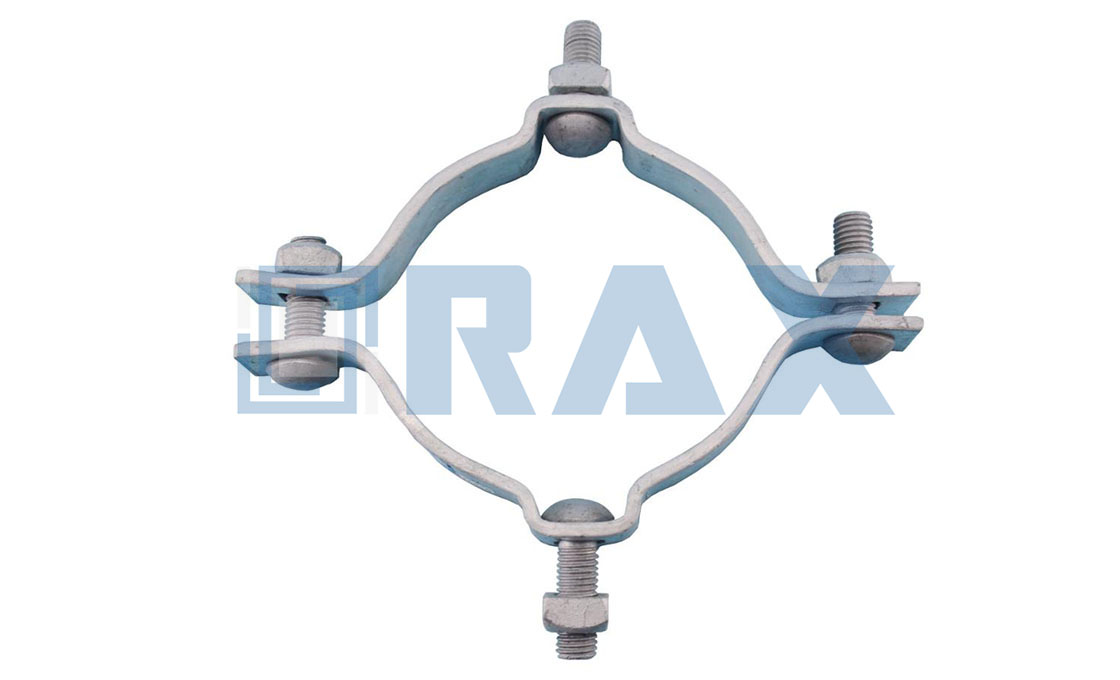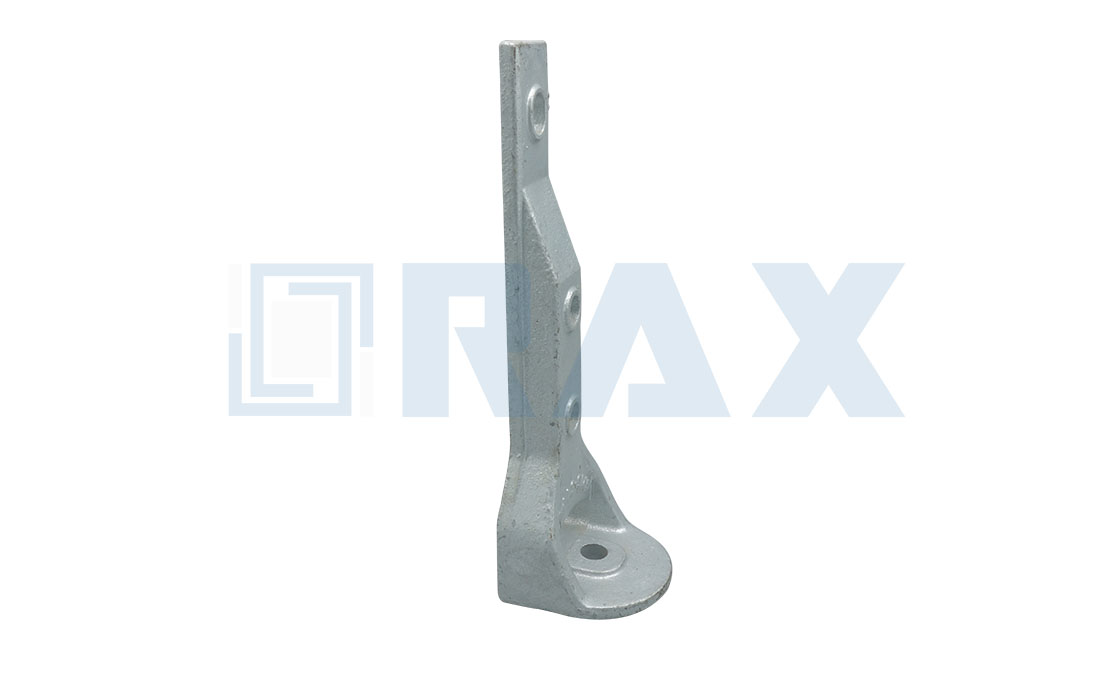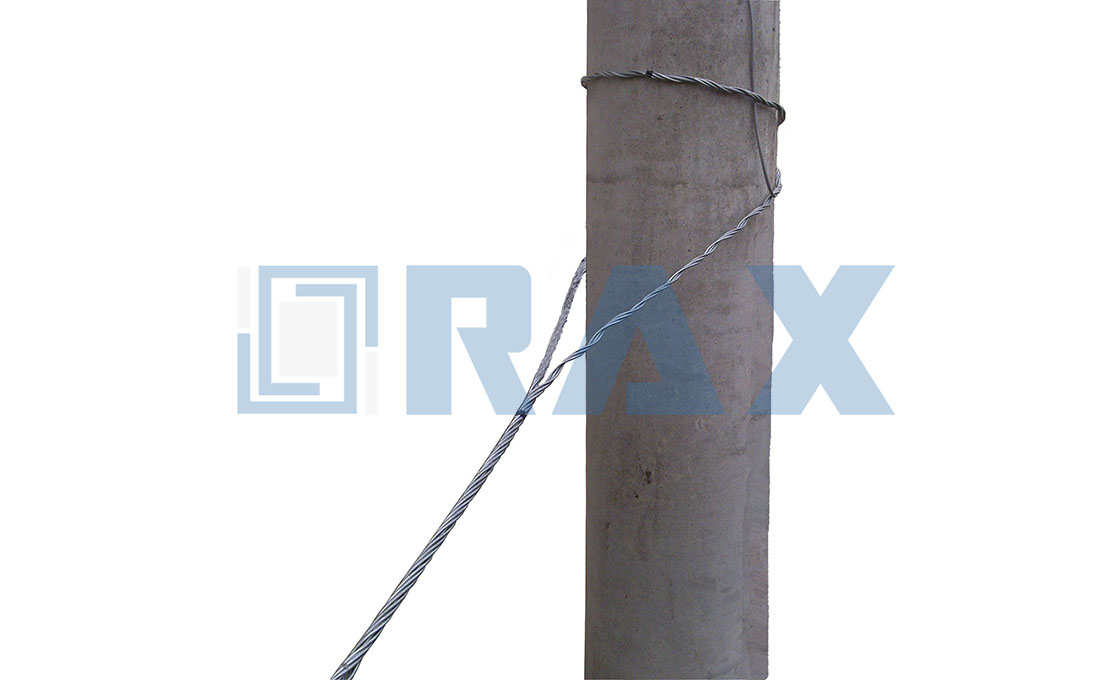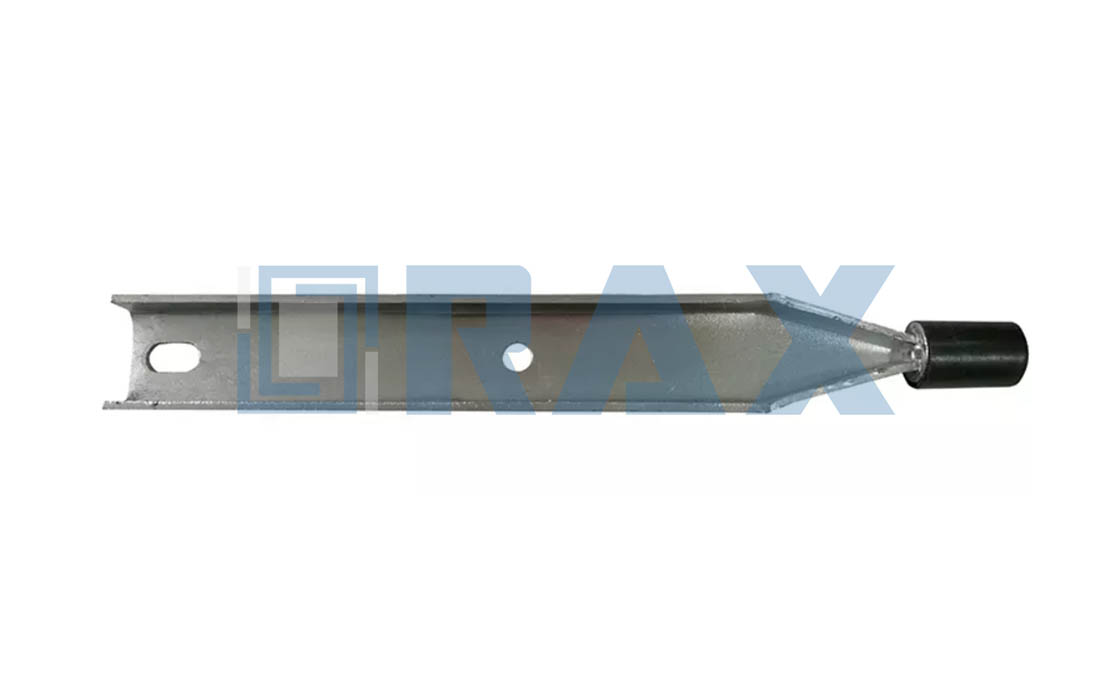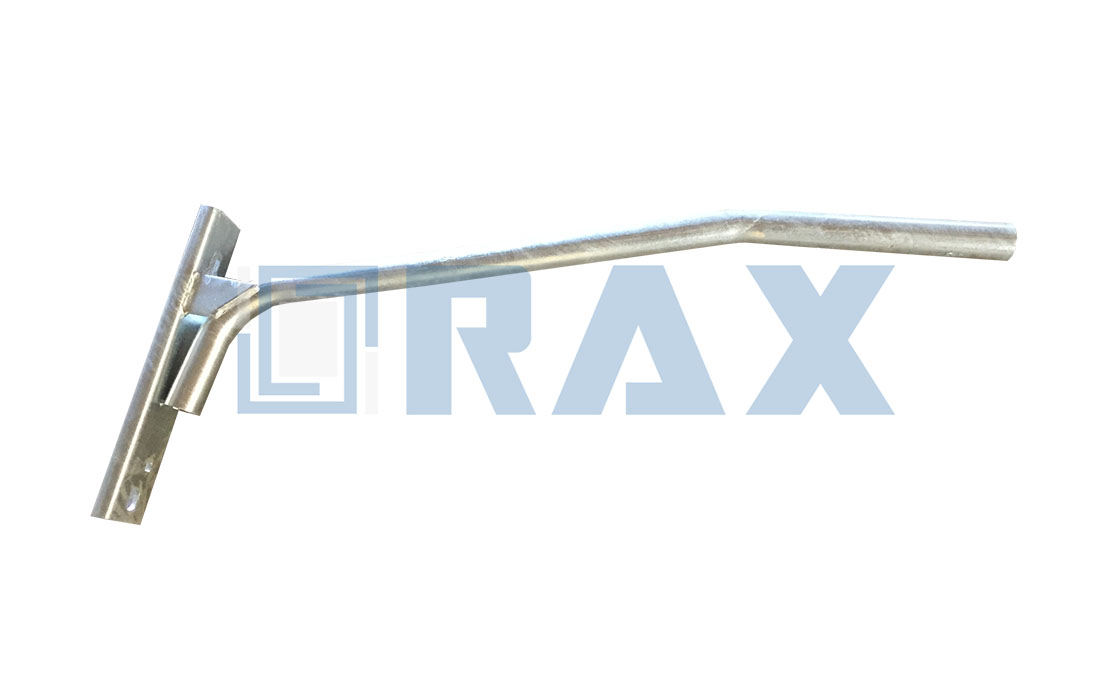Pole Band
The pole band is used to wrap on the pole, it is also named pole fastener, pole fastening clamp, pole band clamp, and pole bracket. According to the structure, there are 3 types of pole bands: single offset pole bands, double offset pole bands, and adjustable pole bands.
According to the application, there are utility pole bands, telephone pole brackets, and cable pole bands. Pole fastening clamps can be used with guy wires. The cable pole band can be commonly used to connect the ADSS and OPGW cables. There is an extended leg on one piece of pole band. The hole on the extended leg will connect the ZH clevis and U clevis.
A pole band is designed to be suitable for use on poles of pole top diameters of 150mm to 280mm. We have supplied a diameter of 155mm, 185mm, 230mm, and so on.
The pole band has a stay tension strength not exceeding 29kn. While the result will be different if a gain grid or some other device is used to transfer the shear load from the pole bolt.
Rax Industry pole band raw material is flat carbon steel, not slitting steel. The raw material is soft and highly malleable. The carbon steel tensile strength is up to 560N/MM2. With the strict selection of the raw material, there will be no broken or cracks on the pole band, after stamping on the flat steel.
The finish of the Rax Industry pole band is hot-dip galvanized according to ISO 1461.
For different pole diameters and voltages, there are different sizes for the pole band clamp. As a leading manufacturer and supplier, Rax Industry can support all sizes of pole bands, we can also make the pole fasteners according to your design.
Pole band structure:
Rax Industry pole band structure is simple. There are two pieces of steel bands in one set. Bolts will fasten the two pieces through the hole on each end leg. This way, the pole band clamp will not drop off from the pole.
For the single offset pole band, there is an outstanding square part in the middle of one piece pole band. On the other piece of single offset pole band, there is no hole in the half-round band. This outstanding part is designed for bolts to go through. This bolt will connect the guy clamp or other pole line hardware. For the double offset pole band, it can support two lines, because, on each half round band, there is an outstanding square part in the middle.
| Size: | According to Rax Industry drawing |
| Description: | ASTM A153 Galvanzied steel Pole band |
| Material: | carbon steel, not steel sheet |
| Finishes: | Hot dip galvanized |
| Packaging: | Cartons & pallets or according to the customer’s requirement |
| Trade Term: | T/T 30% as advance payment and 70% T/T before sending the pole band |
| Feature: | Offset pole bands are used for dead-ending, guying, and mounting secondary racks on metal poles, pipe masts. |
| Our Advantages: | 1. Fast delivery 2. Factory price 3. Good service |
| Note: | You can directly choose the right type according to our drawing size. |


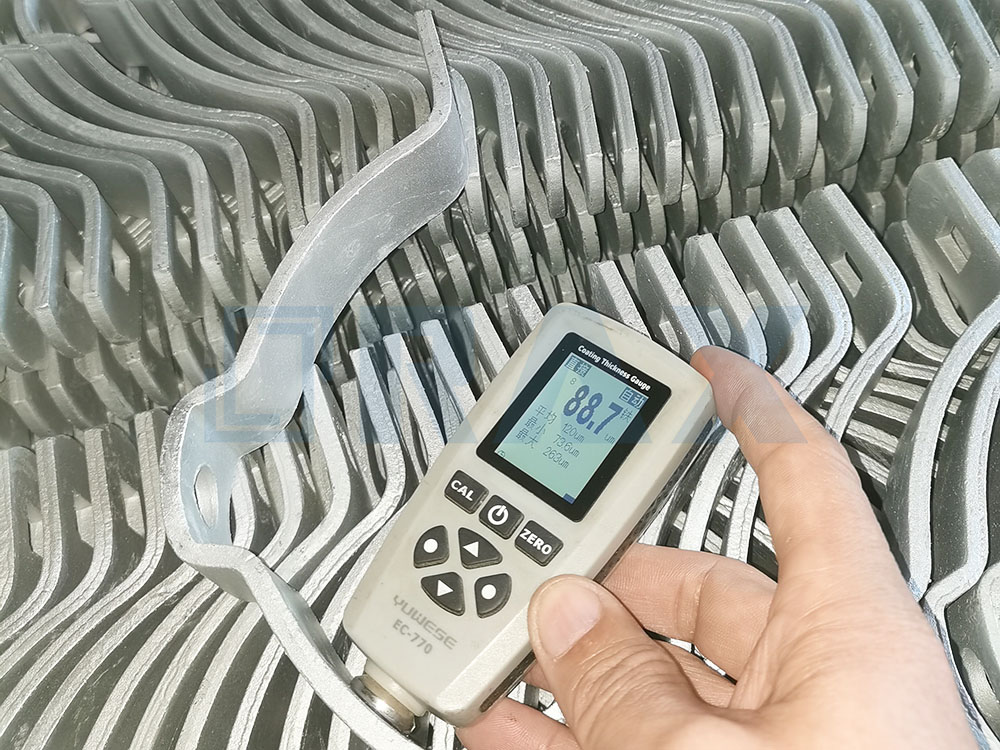
Galvanized Thickness of Pole Bands
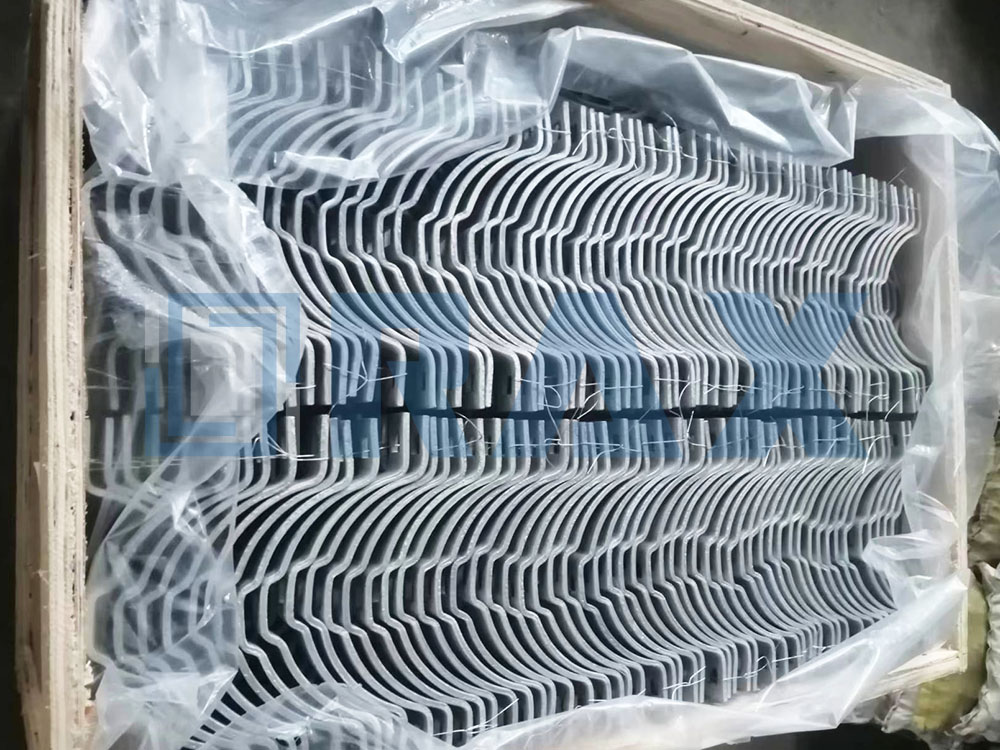 Wooden Package of Pole Bands
Wooden Package of Pole Bands
Pole Band: The Complete Guide
Do you want to hold or secure other pole line accessories on your distribution and transmission lines?
If yes – then you need a pole band.
It is a simple pole line hardware, yet it plays a pivotal role – distribution and transmission lines are not complete without a pole band.
And, today, you’ll learn everything you need to know about pole bands.
From the basic definition, classification, and technical specification to the installation process, among other vital aspects.
Let’s dive right in.
What is Pole Band?
I know you have come across this accessory before.
Have a look at this:
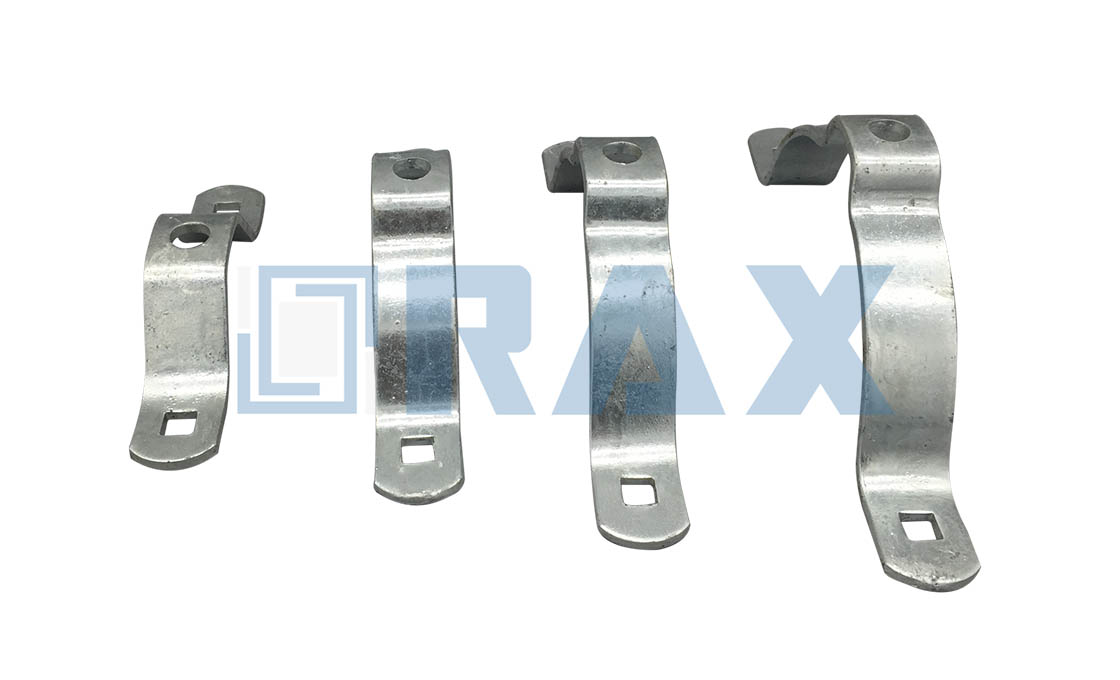 Different sizes of pole bands
Different sizes of pole bands
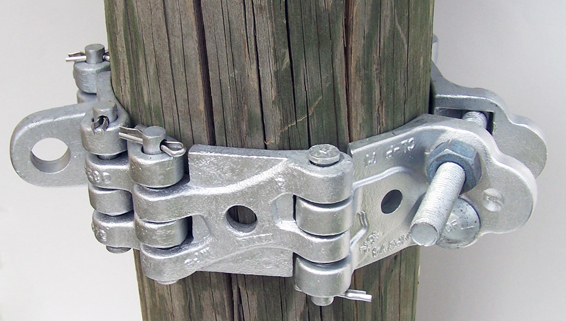
Pole band
So, for those who have been wondering what a pole band looks like in different forms.
Well, figure 1 above shows what it looks like, separated – when not fixed together.
In figure 2 above, you get to know how they look when fixed together with their bolts and nuts.
Now, let me walk you through the nitty-gritty of pole band.
A pole band is also known as a pole fastener, pole band clamp, and pole fastening clamp.
They are used more on poles to make sure they are always fastened ideally in supporting pole line connections.
Types of Pole Bands for Poles?
Most people wonder if there are actually different types of pole bands.
Yes, there is quite a number.
Knowing about them is important.
It helps you know and understand how unique they are.
With this information, you can obviously choose one that suits your unique applications.
Let’s focus on some of the most common types of pole bands for transmission and distribution lines.
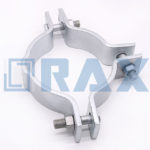 Single pole band
Single pole band
a) Single offset pole band
A single offset pole band is known for its exceptional square part.
This square part can be found in the middle of a piece of pole band.
In most cases, the single offset pole bands come in two sections:
- One round section with holes at the extreme ends
- The second section, has a square part with a hole and two holes at the extreme ends
In most cases, you can use it for guying, mounting secondary racks, dead-ending, etc.
Also, they come in both standard and custom designs.
b) Double offset pole band
You can use the double offset pole band on two lines.
It is because on each half round band you will find unique squares in its middle part.
c) Utility pole bands
These bands are designed for utility poles
d) Cable pole band
Cable pole bands are used ideally in connecting OPGW and ADSS cables.
This type of pole band has an extended leg on one piece of the band.
Holes on extended legs will connect the U clevis and ZH clevis.
e) Telephone bracket pole band
This type is used more for telephone poles and the installation and transmission of cables.
f) Link style pole band
This type of pole band offers you an ideal product for dead-ending and guying to steels, concretes, or wood poles without the necessity for bolt holes within poles.
These bands accommodate pole diameters of different types.
Half and full link style pole bands are ideally available for addition to assemblies to adjust pole diameter ranges of bands.
Components of a Pole Band
As you can see from the figure below, a complete pole band is an assembly of different parts.
These parts include the following:
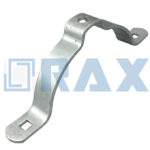 Parts of pole band
Parts of pole band
Steel bands – Steel bands of a pole band are assembled together to tighten the pole.
When you purchase pole bands, make sure all bands are in place depending on the type you purchase.
Fasteners (bolts) – Fasteners are always included when you purchase pole bands.
They are used to fasten bands together in order to have poles well fastened.
Pole fasteners can also be made depending on your designs and needs.
Holes – The holes at the edge of pole bands are mainly for bolts to fasten them together.
These holes when brought together help to create the closure that fastens the pole for all connections.
Clips – These clips help to clip pole bands to these poles.
Cotter key – This component is made from stainless steel.
Link style pole bands mostly have this cotter key coming with them.
Technical Specifications of Pole Bands
Even as you buy pole bands, it is important to focus on some technical specifications.
This way, you will buy a reliable and high-quality accessory.
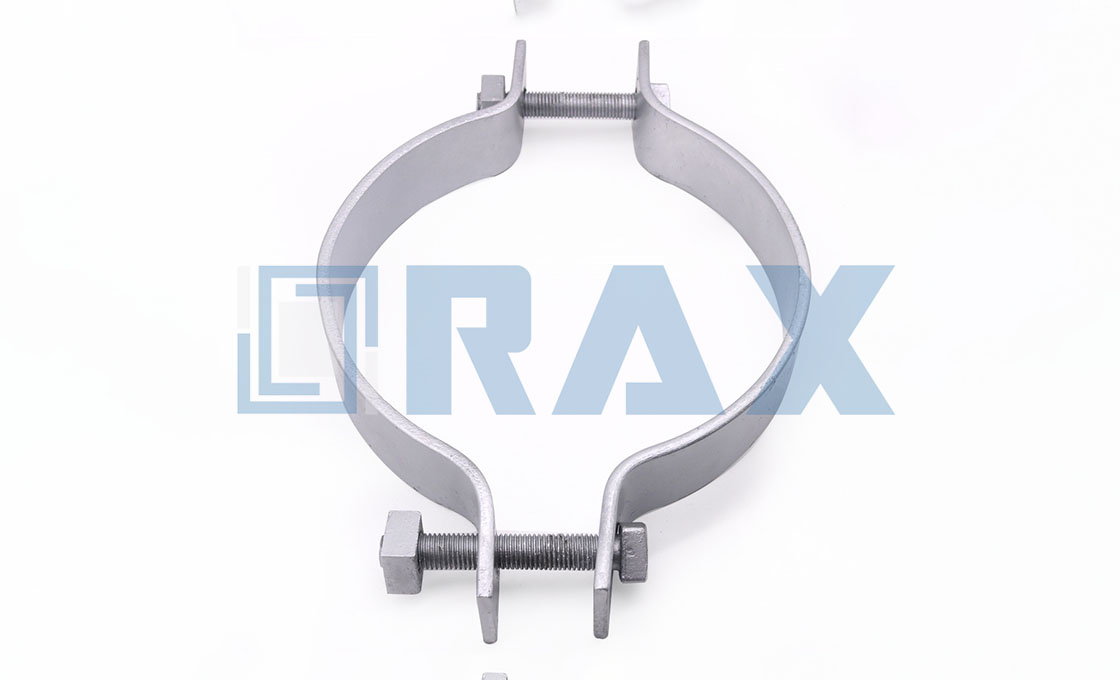 pole band
pole band
Material Type – The raw material used in making pole bands is flat carbon steel and not slitting steel.
This is because flat carbon steel is soft and very malleable compared to other material types.
Finishing – Pole band finish is hot-dip galvanizing and this is according to ISO 1461.
Dimensions – The dimensions of pole bands will also differ from one use to the other.
The length, width, and thickness will depend on the type of application.
Pole band design – They come in different designs.
Of course, you have seen a few I have mentioned earlier in this guide.
However, irrespective of the design, the pole band must fit properly on the pole.
Tensile strength rating – The tensile strength rating of carbon steel is up to 560N/MM2.
This makes the pole band simply strong.
Remember, tensile strength is an important aspect since it determines the amount of load it can support.
Mounting position – Mounting positions of pole bands always differ based on your needs and use.
It will also depend on the design of the pole band.
Diameter – Also, the diameter will depend on the application.
They vary from 180mm, 200mm, 210mm, etc.
How to Install Pole Band?
In fact, installing a pole band is simple and easy.
All you need is suitable fastening equipment and a pole band.
 Fastened pole band
Fastened pole band
Now, let’s see how you can install a pole band.
- Assemble all fastening tools and equipment. These may include hook wrenches, pliers, spanners, etc.
- Now assess your pole band. Ensure it has all the necessary parts and components such as bands and fasteners. More importantly, they should meet your specific application requirements.
- Assemble everything you want to secure on the pole, then bring the pole band together one by one.
- As you bring the bands together use the bolts and nuts to fasten them.
- You can do this by having bolts put into each end leg. Then you can fasten it. This is important to make sure nothing drops off from the pole, especially the pole band clamp.
- Make sure the pole band is installed to wrap the pole tightly, keeping it fastened.
- At times, once you install the pole band, you can go ahead to put other accessories.
In a nutshell, installing a pole band is simple and straight forward.
Frequently Asked Questions (FAQs)
What is a pole band?
Pole band is hardware that consists of two or more pieces of steel bands. Pole band is widely used on steel, wood, or concrete poles to make sure that it is always fastened ideally in supporting pole line connections.
The Pole band is also called pole fastener, pole fastening clamp, pole band clamp, and pole bracket.
What is the pole band mainly used for?
The pole band is mainly used to fasten the pole so that it will support the pole line connection.
What is the raw material of the pole band?
The material for the pole band is hot rolled carbon steel, not cut sheet.
What is the diameter of pole bands?
For different pole diameters and voltages, there are different sizes for the pole band. Here are several commonly used diameters:180mm, 200mm, and 210mm, other sizes of pole bands also can be manufactured according to the design.
What are the types of pole bands?
There are many types used on transmission and distribution lines, here are some common ones:
- Single offset pole band
- Double offset pole band
- Utility pole bands
- Cable pole band
- Telephone bracket pole band
- Link style pole band
What are the technical specifications of pole bands?
When choosing pole bands, it is important to focus on some technical specifications:
- Material Type
- Pole band design
- Mounting position
- Dimensions
- Diameter
- Tensile strength rating
- Galvanizing
Conclusion
As you can see, a pole band is simple yet important pole line hardware.
You can use it to secure virtually anything on a pole.
However, you must buy a suitable pole band in terms of technical specifications.
Here at Rax Industry, we design and manufacture high-quality pole bands.
Talk to us today and we will help you choose a suitable pole band.
